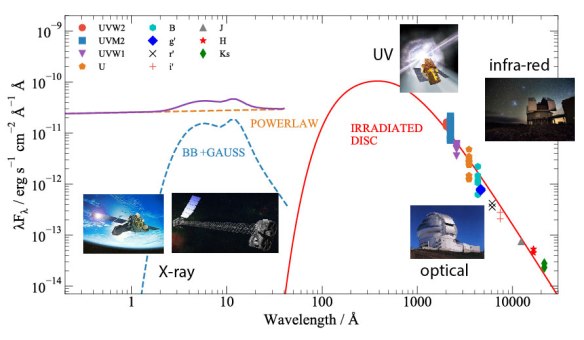Neutron stars and black holes are the collapsed remnants of once massive stars that ended their life in a supernova explosion. A defining property of neutron stars and black holes is that their mass is compressed into a very small volume and therefore these stellar corpses are also referred to as compact objects.
One direct consequence of their compactness is that neutron stars and black holes exert immense gravity. When they are part of a binary star system, this allows them to pull off gas from their companion star and swallow this material to their own benefit (e.g. to increase their own mass and spin). This process of mass transfer is called accretion and plays an important role throughout the universe. Understanding exactly how neutron stars and black holes eat, and how much they spit back into space, is therefore a very active area of research.
Accretion onto compact objects leads to the liberation of enormous amounts of gravitational energy, which is carried into space as electromagnetic radiation. Most of the energy is released in the inner part of the gaseous disk that forms around the neutron star or black hole. The temperatures in this part of the disk are billions of degrees Celsius, which implies that the radiation is visible at X-ray wavelengths. For this reason, accreting neutron stars and black holes are called X-ray binaries.
Despite that X-ray binaries radiate most prominently in the X-rays, the cooler parts of their accretion disks emit at ultra-violet (UV), optical and infrared wavelengths, while the material that is blown back into space is typically detected in the radio band. Furthermore, their companion star also emits optical, infrared, and sometimes UV, radiation. Although the accretion in X-ray binaries is typically studied with X-ray telescopes, forming a complete picture of all components involved in the accretion process requires studying X-ray binaries at all wavelengths, from X-ray and UV to optical and infrared, all the way to radio. Such multi-wavelength studies are highly challenging, however, because every different wavelength requires another observatory and the data acquisition, reduction and analysis techniques are widely different.
In an effort to elucidate the puzzling nature of the intriguing neutron star X-ray binary IGR J17062-6143, we carried out an ambitious multi-wavelength observing campaign. We used three satellites (NuSTAR, XMM-Newton, and the Neil Gehrel’s Swift observatory), as well as two large ground-based telescopes (Gemini South and Magellan) to understand i) if the neutron star in this X-ray binary is stopping the accretion flow with its magnetic field, ii) if part of the accreted gas is blown away in a wind, and iii) if the accretion disk has a size similar to other X-ray binaries or is comparatively small.
Jakob utilized a total of four different X-ray analysis techniques (broad-band X-ray spectral fitting, reflection spectroscopy, high-resolution X-ray spectroscopy and coherent X-ray timing) to zoom in on the properties of the hot inner part of the accretion flow, near the neutron star. Among his main findings are that the inner part of the gas disk does not extend close to the neutron star as is usually the case in X-ray binaries, but is truncated well away from it (question i above). Secondly, he found evidence for an outflowing wind (question ii above), which may be related to the fact that the inner disk is vacated (e.g. the magnetic field of the neutron star may be pushing the gas away and expelling it into a wind). Finally, he found evidence for unusually high abundances of oxygen in the gas surrounding the neutron star. This could indicate that the companion star is very old, which ties in with our other multi-wavelength data analyzed by Juan.
Juan did an amazing job at combining the information from various different wavelengths to understand the size of the accretion disk in IGR J17062-6143 in (question iii above). Fitting the multi-wavelength spectral-energy distribution to accretion models, he found that the gas disk in this X-ray binary must be exceedingly small compared to other systems. In particular, he found that the companion star must be orbiting the neutron star in less than an hour, which implies that the companion must be a very old, small star. Such old stars have lost all their hydrogen and as a result the accretion that they feed has a more exotic chemical composition, which can explain the abundance of oxygen found in Jakob’s X-ray analysis.
X-ray binaries with very small orbits and old companions are called ultra-compact X-ray binaries. Only about a dozen of such systems are known, but their is high desire to find more of them. For instance, characterizing ultra-compact binaries is very important for understanding how binary stars evolve. Furthermore, these systems are expected to emit gravitational waves that should be detectable with future gravitational wave detectors such as LISA.
Our efforts demonstrated the power of multi-wavelength studies to gain a deeper understanding of accretion processes and to find rare, exotic X-ray binaries.
van den Eijnden, Degenaar, Pinto et al. 2018, MNRAS 475, 2027: The very faint X-ray binary IGR J17062-6143: a truncated disc, no pulsations, and a possible outflow
Paper link: ADS
Hernández Santisteban, Cuneo, Degenaar et al. 2019, MNRAS in press: Multi-wavelength characterisation of the accreting millisecond X-ray pulsar and ultra-compact binary IGR J17062-6143
Paper link: ADS

Accumulation of multi-wavelength data for the neutron star X-ray binary IGR J17062-6143. Shown is the spectral-energy distribution that was obtained with three different satellites and two ground-based telescopes. This image is adopted from Juan’s paper.

You must be logged in to post a comment.